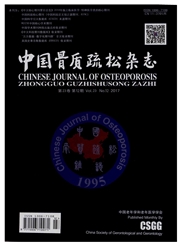

 中文摘要:
中文摘要:
废用性骨质疏松症属于继发性骨质疏松症的一种,其主要为破骨与成骨失衡的结果。力学因素、细胞因子、神经生长因子在废用性骨质疏松的发生发展中起了重要的作用,但对其具体的发病机制仍存在争议。长期卧床、制动、失重是导致废用性骨质疏松发生的三大病因。废用性骨质疏松的常见表现为骨质疏松性骨痛、骨的脆性增加、骨折的风险提高。目前对于废用性骨质疏松的诊断也主要根据病史、临床表现、体格检查以及骨代谢物的生化检查进行判断。但在废用性骨质疏松症骨反应的不同阶段,患者的临床表现和骨代谢物水平存在差异。因此,针对废用性骨质疏松的防治也应从药物、理疗、功能锻炼等多方面进行。
 英文摘要:
英文摘要:
Disuse osteoporosis is one kind of diseases of secondary osteoporosis, mainly due to the imbalance of bone resorption and ossification. Mechanical factors, cytokines, and nerve growth factor play an important role in its occurrence and development. But its specific mechanism is still controversial. Long-term bedding, braking, and weight loss are the 3 major causes of disuse osteoporosis. The common manifestations of disuse osteoporosis are osteoporotic ostealgia, increased bone fragility, and increased risk of fractures. At present, the diagnosis of disuse osteoporosis is mainly according to the medical history, clinical manifestations, physical examinations, and biochemical examinations of the bone metabolites. But at the different stages of disuse osteoporosis, clinical manifestations and bone metabolite levels of patients are different. Thus, the prevention and treatment of disuse osteoporosis should be conducted from different aspects including drugs, physical therapy, and functional exercise.
 同期刊论文项目
同期刊论文项目
 同项目期刊论文
同项目期刊论文
 期刊信息
期刊信息
